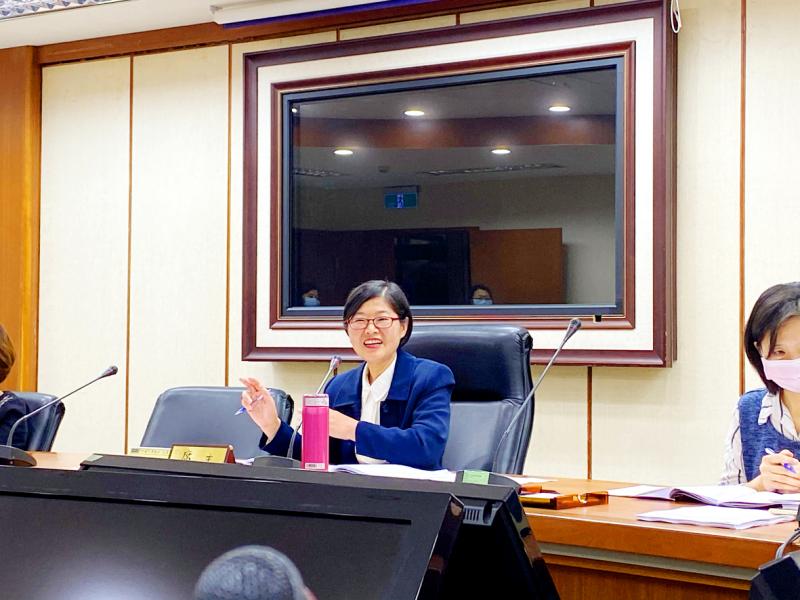Export orders declined 0.8 percent year-on-year last month to US$28.68 billion as the COVID-19 pandemic disrupted production, supply chains and logistics in China, the Ministry of Economic Affairs said yesterday.
On a monthly basis, export orders contracted 18.8 percent from US$35.31 billion, ministry statistics showed.
The ministry said it expects the decline to accelerate this month.

Photo: Huang Pei-chun, Taipei Times
Orders for information and communications technology (ICT) products, one of Taiwan’s most important export categories, was most affected as orders fell 23.4 percent year-on-year to US$6.05 billion.
“More than 90 percent of ICT products, comprised of smartphones, laptops and servers, are manufactured in China, which makes them particularly vulnerable when the country deployed stringent anti-epidemic measures,” Department of Statistics Director Huang Yu-ling (黃于玲) said.
ICT product makers reacted swiftly by moving production back to Taiwan, Huang said.
“This holds true for all product categories, as manufacturers increasingly shift production back home to mitigate the effects of the coronavirus,” Huang said, adding that overall overseas production fell to 40.7 percent last month, hitting a 15-year low.
Meanwhile, export orders for electronics bounced back after a small contraction in January to surge 20.4 percent year-on-year to US$8.82 billion, due to growing demand for semiconductors.
“Upcoming 5G deployment boosted orders for foundry services, design and packaging of integrated circuits as well as memory products,” Huang said.
However, export orders for optoelectronics continued a downward spiral despite an increase in demand for optical lenses, as flat-panel prices struggle to recover.
With part of their production in China hindered, optoelectronics makers posted a 14.7 percent year-on-year decline to US$1.34 billion in orders last month, the data showed.
Orders for traditional manufactured goods, with the exception of petrochemicals, increased by between 1.4 percent and 14.3 percent on an annual basis last month due to a low comparison base.
“While this may seem to provide some respite for traditional manufacturers after incessant declines last year, this situation is unlikely to persist ... especially not for petrochemicals, rubber and plastic products,” Huang said, referring to the recent slump in oil prices.
As COVID-19 spreads worldwide, hitting Europe and the US, export orders are expected to continue to decline this month by between 3.2 percent and 9.3 percent on an annual basis to US$33.5 billion to US$35 billion.
“The virus outbreak in China mainly upset the supply end ... but now we might be facing disruptions on end markets,” Huang said, forecasting a more than US$2 billion decline in orders for ICT makers, which are expected to be the most affected.

CHIP RACE: Three years of overbroad export controls drove foreign competitors to pursue their own AI chips, and ‘cost US taxpayers billions of dollars,’ Nvidia said China has figured out the US strategy for allowing it to buy Nvidia Corp’s H200s and is rejecting the artificial intelligence (AI) chip in favor of domestically developed semiconductors, White House AI adviser David Sacks said, citing news reports. US President Donald Trump on Monday said that he would allow shipments of Nvidia’s H200 chips to China, part of an administration effort backed by Sacks to challenge Chinese tech champions such as Huawei Technologies Co (華為) by bringing US competition to their home market. On Friday, Sacks signaled that he was uncertain about whether that approach would work. “They’re rejecting our chips,” Sacks

Taiwan’s exports soared 56 percent year-on-year to an all-time high of US$64.05 billion last month, propelled by surging global demand for artificial intelligence (AI), high-performance computing and cloud service infrastructure, the Ministry of Finance said yesterday. Department of Statistics Director-General Beatrice Tsai (蔡美娜) called the figure an unexpected upside surprise, citing a wave of technology orders from overseas customers alongside the usual year-end shopping season for technology products. Growth is likely to remain strong this month, she said, projecting a 40 percent to 45 percent expansion on an annual basis. The outperformance could prompt the Directorate-General of Budget, Accounting and

NATIONAL SECURITY: Intel’s testing of ACM tools despite US government control ‘highlights egregious gaps in US technology protection policies,’ a former official said Chipmaker Intel Corp has tested chipmaking tools this year from a toolmaker with deep roots in China and two overseas units that were targeted by US sanctions, according to two sources with direct knowledge of the matter. Intel, which fended off calls for its CEO’s resignation from US President Donald Trump in August over his alleged ties to China, got the tools from ACM Research Inc, a Fremont, California-based producer of chipmaking equipment. Two of ACM’s units, based in Shanghai and South Korea, were among a number of firms barred last year from receiving US technology over claims they have

BARRIERS: Gudeng’s chairman said it was unlikely that the US could replicate Taiwan’s science parks in Arizona, given its strict immigration policies and cultural differences Gudeng Precision Industrial Co (家登), which supplies wafer pods to the world’s major semiconductor firms, yesterday said it is in no rush to set up production in the US due to high costs. The company supplies its customers through a warehouse in Arizona jointly operated by TSS Holdings Ltd (德鑫控股), a joint holding of Gudeng and 17 Taiwanese firms in the semiconductor supply chain, including specialty plastic compounds producer Nytex Composites Co (耐特) and automated material handling system supplier Symtek Automation Asia Co (迅得). While the company has long been exploring the feasibility of setting up production in the US to address